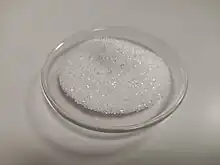Tetrasodium pyrophosphate
Tetrasodium pyrophosphate, also called sodium pyrophosphate, tetrasodium phosphate or TSPP, is an inorganic compound with the formula Na4P2O7. As a salt, it is a white, water-soluble solid. It is composed of pyrophosphate anion and sodium ions. Toxicity is approximately twice that of table salt when ingested orally.[3] Also known is the decahydrate Na4P2O7 · 10(H2O).[4]
 | |
 | |
| Names | |
|---|---|
| IUPAC name
Tetrasodium diphosphate | |
| Other names
Pyrophosphate, Sodium pyrophosphate, Tetrasodium pyrophosphate (anhydrous), TSPP[1] | |
| Identifiers | |
| |
3D model (JSmol) |
|
| ChEBI | |
| ECHA InfoCard | 100.028.880 |
| EC Number |
|
| E number | E450(iii) (thickeners, ...) |
PubChem CID |
|
| RTECS number |
|
| UNII |
|
CompTox Dashboard (EPA) |
|
| |
| |
| Properties | |
| Na4O7P2 | |
| Molar mass | 265.900 g·mol−1 |
| Appearance | Colorless or white crystals[2] |
| Odor | odorless |
| Density | 2.534 g/cm3 |
| Melting point | 988 °C (1,810 °F; 1,261 K) (anhydrous) 79.5 °C (decahydrate) |
| Boiling point | decomposes |
| 2.61 g/100 mL (0 °C) 6.7 g/100 mL (25 °C) 42.2 g/100 mL (100 °C) | |
| Solubility | insoluble in ammonia, alcohol |
Refractive index (nD) |
1.425 |
| Structure | |
| monoclinic (decahydrate) | |
| Thermochemistry | |
Heat capacity (C) |
241 J/mol K |
Std molar entropy (S⦵298) |
270 J/mol K |
Std enthalpy of formation (ΔfH⦵298) |
-3166 kJ/mol |
Gibbs free energy (ΔfG⦵) |
-3001 kJ/mol |
| Hazards | |
| Flash point | Non-flammable |
| NIOSH (US health exposure limits): | |
PEL (Permissible) |
none[2] |
REL (Recommended) |
TWA 5 mg/m3[2] |
IDLH (Immediate danger) |
N.D.[2] |
| Related compounds | |
Other anions |
Trisodium phosphate Pentasodium triphosphate Sodium hexametaphosphate |
Other cations |
Tetrapotassium pyrophosphate |
Related compounds |
Disodium pyrophosphate |
Except where otherwise noted, data are given for materials in their standard state (at 25 °C [77 °F], 100 kPa).
Infobox references | |
Use

Tetrasodium pyrophosphate is used as a buffering agent, an emulsifier, a dispersing agent, and a thickening agent, and is often used as a food additive. Common foods containing tetrasodium pyrophosphate include chicken nuggets, marshmallows, pudding, crab meat, imitation crab, canned tuna, and soy-based meat alternatives and cat foods and cat treats where it is used as a palatability enhancer.
In toothpaste and dental floss, tetrasodium pyrophosphate acts as a tartar control agent, serving to remove calcium and magnesium from saliva and thus preventing them from being deposited on teeth. Tetrasodium pyrophosphate is used in commercial dental rinses before brushing to aid in plaque reduction.
Tetrasodium pyrophosphate is sometimes used in household detergents to prevent similar deposition on clothing, but due to its phosphate content it causes eutrophication of water, promoting algae growth.
Production
Tetrasodium pyrophosphate is produced by the reaction of furnace-grade phosphoric acid with sodium carbonate to form disodium phosphate, which is then heated to 450 °C to form tetrasodium pyrophosphate:[5]
- 2 Na2HPO4 → Na4P2O7 + H2O
References
- CDC - NIOSH Pocket Guide to Chemical Hazards
- NIOSH Pocket Guide to Chemical Hazards. "#0606". National Institute for Occupational Safety and Health (NIOSH).
- Handbook of food toxicology, S. S. Deshpande, page 260
- D.L. Perry S.L. Phillips (1995) Handbook of inorganic compounds CRC Press ISBN 0-8493-8671-3
- Klaus Schrödter; Gerhard Bettermann; Thomas Staffel; Friedrich Wahl; Thomas Klein; Thomas Hofmann. "Phosphoric Acid and Phosphates". Ullmann's Encyclopedia of Industrial Chemistry. Weinheim: Wiley-VCH. doi:10.1002/14356007.a19_465.pub3.